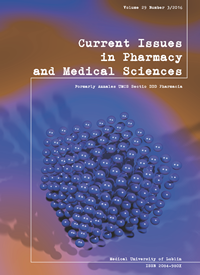Evaluation of the surface structure of composite restorations in light of own pilot research
DOI:
https://doi.org/10.1515/cipms-2016-0022Słowa kluczowe:
dental composites, surface assessment, 3D analysisAbstrakt
Research on the dental restorative materials employed in remedying dental cavities has been conducted on many levels and areas, both with application of clinical and laboratory methods. One of the elements that determines whether the restoration may be degraded is the condition of its surface. The aim of the study was to assess the texture surface of composite restorations using a non-contact method of teeth models scanning. In this work, ten medium size cavities on the occlusal surfaces of molars in adult patients were prepared and restored with resin composite. Before undertaking the procedure and after the finishing and polishing of the restorations, impressions were taken and sent into the laboratory so as to prepare plaster casts. Every cast was then scanned utilizing the non-contact 3D surface measurement instrument so as to assess the texture surface of the restoration. The resulting three dimensional analyses of post-restoration models showed the correct marginal adaptation of resin composite dental material to the hard tooth structures and its smooth filling occlusal surface. Additional comparison of scans done before and after restoring the cavities allowed the calculating of differences in volume, mean and maximum heights. The applied method of analysis is thought to be helpful in the detailed evaluation of restoration dental material texture. Moreover, the enabled possibility of continuous observation is expedient for assessing the usefulness of the method in standard dental practice.Bibliografia
1. Batko K. et al.: Characteristics of the surface layer of selected glass-ionomer cements by inverse gas chromatography in increased humidity conditions. Polimery, 51, 280, 2006.
2. Chałas R. et al.: Assessment of dentin reaction after Biodentine application. Curr. Iss. Pharm. Med. Sci., 26, 435, 2013.
3. Chałas R. et al.: Long-term clinical performance of experimental glass-ionomer cement with the bi-functional fluid. J. Pre-Clin. Clin. Res., 9, 109, 2015.
4. Jamróz-Wilkońska L., Wilkoński W., Krupiński J.: Evaluation of surface roughness of composite materials using an Atomic Force Microscope (AFM) after polishing with different polishing systems. Mag. Stomat., 26, 144, 2014.
5. Jamróz-Wilkońska L., Wilkoński W., Krupiński J.: The spectrophotometric evaluation of surface discolourations of composite materials after polishing with different polishing systems. e-Dentico, 35, 70, 2012.
6. Li Y. et al.: Effect of filler content and size on properties of composites. J. Dent. Res., 64, 1396, 1985.
7. Łagan S.: Estimation of possibility of application of CIMM technique for direct composite fillings in the 1st and 2nd class cavities according to Black. Akt. Probl. Biomech., 3, 131, 2009.
8. Mystowska J., Dąbrowski J.R.: Tribological characteristics of kinematics couple: tooth-composite material for permanent dental fillings. Ekspl. i Niezawod. – Maint. and Reliabil., 12, 4, 2010.
9. Nagarajan V.S., Jahanmir S., Thompson V.P.: In vitro contact wear of dental composites. Dent. Mater., 20, 63, 2004.
10. Olek A., Klimek L., Bołtacz-Rzepkowska E.: Research methods of material engineering used in dental experimental studies. Mag. Stomat., 17, 66, 2015.
11. Ono M. et al.: Surface properties of resin composite materials relative to biofilm formation. Dent. Mater. J., 26, 613, 2007.
12. Orłowski M., Tarczydło B., Chałas R.: Evaluation of marginal integrity of four bulk-fill dental composite materials: in vitro study. Sci. World J., 2015; 2015:701262. doi: 10.1155/2015/701262. Epub 2015 Mar 22.
13. Turssi C.P., Rodrigues A.L. Jr., Serra M.C.: Textural characterization of finished and polished composites over time of intraoral exposure. J. Biomed. Mater. Res. B Appl. Biomater., 76, 381, 2006.
14. Watanabe T. et al. Influence of polishing duration on surface roughness of resin composites. J. Oral Sci., 47, 21, 2005.
15. Yazici A.R., Muftu A., Kugel G.: Three-dimensional surface profile analysis of different types of flowable restorative resins following different finishing protocols. J Contemp. Dent. Pract., 5, 9, 2007.
Pobrania
Opublikowane
Numer
Dział
Licencja
Prawa autorskie (c) 2016 Autorzy

Praca jest udostępniana na licencji Creative Commons Attribution-NonCommercial-NoDerivatives 3.0 Unported License.


